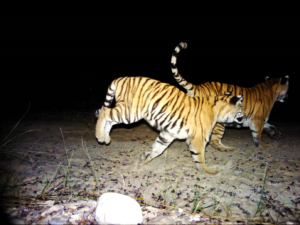Last week we received the interim report from the ZSL Nepal team that are using their WildCats grant in the Parsa National Park (PNP) to continue monitoring the tiger population and provide enhanced protection for the tigers through training National Park and Army staff in antipoaching and patrolling techniques.
 This year, the camera trap monitoring became part of the all Nepal tiger census, the first since 2013. Monitoring in all five National Parks took over five months. The Ecology section of the Department of National Parks and Wildlife Conservation (DNPWC) led the national survey with support from conservation partners National Trust for Nature Conservation (NTNC), ZSL and World Wildlife Fund (WWF).
This year, the camera trap monitoring became part of the all Nepal tiger census, the first since 2013. Monitoring in all five National Parks took over five months. The Ecology section of the Department of National Parks and Wildlife Conservation (DNPWC) led the national survey with support from conservation partners National Trust for Nature Conservation (NTNC), ZSL and World Wildlife Fund (WWF).
Camera trapping is not without its problems, not least loss or damage of cameras. According to the report, 81 cameras were lost or damaged. Of those 57 were stolen or damaged by humans, 22 by elephants and 2 by tigers. In addition to these, 8 cameras taken away by people were recovered (either returned to the forest or given to police), 3 cameras taken by tigers and 2 taken by elephants were also found working.
The data from all of these surveys is now being analysed by the DNPWC and the results will be released shortly, though the date hasn’t been released yet. The Nepal Government is committed to conserving the tiger and is striving to double tiger numbers by 2022, the target set by the St Petersburgh Declaration in 2010, so with only four years to go, these latest figures are crucial.
 Training the staff in PNP in antipoaching methodology and techniques has been carried out in the area by ZSL since 2014. Refresher training and training of new staff for three new guard posts in the Parsa extension area took place in June for both National Park and Army personnel.
Training the staff in PNP in antipoaching methodology and techniques has been carried out in the area by ZSL since 2014. Refresher training and training of new staff for three new guard posts in the Parsa extension area took place in June for both National Park and Army personnel.
Of interest in the report is that Nepal will be using their own patrol monitoring software to collect patrol data in the main area of PNP from now on. This government commitment to patrol based data collection through their own real-time system shows a really positive step for sustainable in-country tiger conservation.
You can read more about the tiger monitoring and training in the full interim report.

